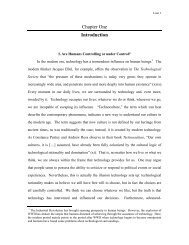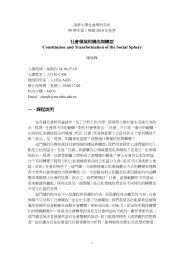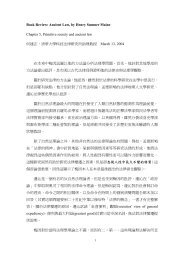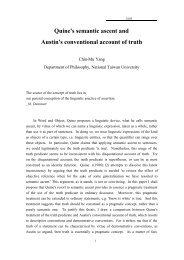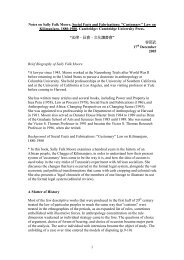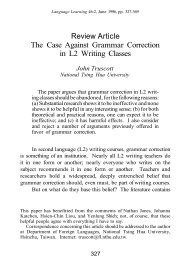Effects of Graded Texts on EFL College Students' Incidental ...
Effects of Graded Texts on EFL College Students' Incidental ...
Effects of Graded Texts on EFL College Students' Incidental ...
Create successful ePaper yourself
Turn your PDF publications into a flip-book with our unique Google optimized e-Paper software.
the three sources. It was c<strong>on</strong>cluded that a general service vocabulary <str<strong>on</strong>g>of</str<strong>on</strong>g> close to<br />
2000 words is suitable and sufficient for learners who are moving towards a<br />
specialized vocabulary. Also, after learners have achieved this 2000 word level, a<br />
specialized vocabulary such as UWL will c<strong>on</strong>tribute to more text coverage than the<br />
next words in the general word lists.<br />
While learning vocabulary by word lists does dem<strong>on</strong>strably result in eminently<br />
word growth, cauti<strong>on</strong> is needed for incorporating standard word lists as teaching<br />
material. As was warned by Ghadessy (1979), the idea <str<strong>on</strong>g>of</str<strong>on</strong>g> standard word lists<br />
“ignores the simple fact that the acquisiti<strong>on</strong> <str<strong>on</strong>g>of</str<strong>on</strong>g> new vocabulary items differ for<br />
various language learners because <str<strong>on</strong>g>of</str<strong>on</strong>g> differences in linguistic, cultural, and<br />
motivati<strong>on</strong>al factors" (p. 25). In other words, no particular word list or sets <str<strong>on</strong>g>of</str<strong>on</strong>g><br />
word list can satisfy all learners, and word lists should be c<strong>on</strong>tingent up<strong>on</strong> and<br />
carefully tailored for learners’ specific needs.<br />
The above studies amply dem<strong>on</strong>strated the following c<strong>on</strong>tenti<strong>on</strong>s.<br />
1. Using high frequency word lists to select appropriate instructi<strong>on</strong>al material can<br />
substantively accelerate learners’ vocabulary growth.<br />
2. Selecti<strong>on</strong> or development <str<strong>on</strong>g>of</str<strong>on</strong>g> particular sets <str<strong>on</strong>g>of</str<strong>on</strong>g> word lists should be c<strong>on</strong>diti<strong>on</strong>al<br />
up<strong>on</strong> learners’ specific needs.<br />
2.4. Vocabulary Acquisiti<strong>on</strong> Through Sequencing <str<strong>on</strong>g>of</str<strong>on</strong>g> Reading <str<strong>on</strong>g>Texts</str<strong>on</strong>g><br />
Vocabulary difficulties encountered by L2 students in authentic reading texts are<br />
major stumbling blocks to reading comprehensi<strong>on</strong> and also further acquisiti<strong>on</strong> <str<strong>on</strong>g>of</str<strong>on</strong>g> new<br />
words. Laufer (1989) found that learners whose vocabulary size enabled them to<br />
cover 95% <str<strong>on</strong>g>of</str<strong>on</strong>g> the words in a text were successful in achieving satisfactory text<br />
comprehensi<strong>on</strong>. Under the c<strong>on</strong>diti<strong>on</strong> that learners are able to use c<strong>on</strong>textual<br />
inference strategies for incidental vocabulary acquisiti<strong>on</strong>, Laufer (1997) and Nati<strong>on</strong><br />
13



